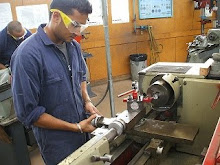What type of gears are used for forward and reverse in a manual gearbox? Give an explanantion for your choice.
The above pic is a straight cut or spur gear which is used for reverse gear in automotive gearboxes. The reverse driven gear, idler and driving gear is all strait cut. This is used because the gears are easily engaged.
The above pic is a helical cut gear which is used for forward gear in the automotive gearbox. There is more contact space therefore the gears are more stronger, quieter and smoother than the straight cut gear.
What is the purpose of a bualk (synchro) ring?
The Baulk ring ensures the gear changes are smooth and quiet by preventing the gears to be engaged until both components coming into contact are at the same speed. The baulk ring speeds up or slows down a gear before engagement.
What is the purpose of a synchromesh unit? Explain the operation of a synchromesh unit.
The syncromesh unit has a hub, a sleeve , bearings and the baulk ring. When a gear is selected, the shift fork pushes or pulls on the sleeve. As it moves, the small teeth engage the teeth on the synchro ring, which causes the synchro ring to rotate at the same rate as the synchrmesh assembly, which are splined to each other as well as the output shaft. As the sleeve continues to move toward the gear, the inside of the synchro ring is pressed up against the conical shaped part of the gear. This causes the gear to match speed with the synchrmesh, and once the speeds are matched, the synchronizer sleeve continues to slide toward the gear, engaging the teeth on the side of the gear.
What type of bearings do we find in gearboxes?
We find a lot of different types of bearing in gearboxes. We have needle roller bearings inside the input shaft. We also have caged needle roller and main shaft bearings which are bigger. The bearings differ due to load capcity, size and type for the application.
Give an explanation of a gear ratio.
A gear ratio of a gear box is the ratio of the speed of the input shaft to the speed of the output shaft. The gear ratio comes form the teeth on the gears. The driver gear drives the driven gear. If both the teeth of the driver and driven gear are the same the ratio is equal to 1:1. Different gear ratios allow the final drive to achieve different speeds and torques.
References
Subscribe to:
Post Comments (Atom)







Excellent work with well thought out and sourced information.
ReplyDeleteThese gearboxes can be used for several years, and timely maintenance is all you would need to uphold their performance. Nice work!
ReplyDelete